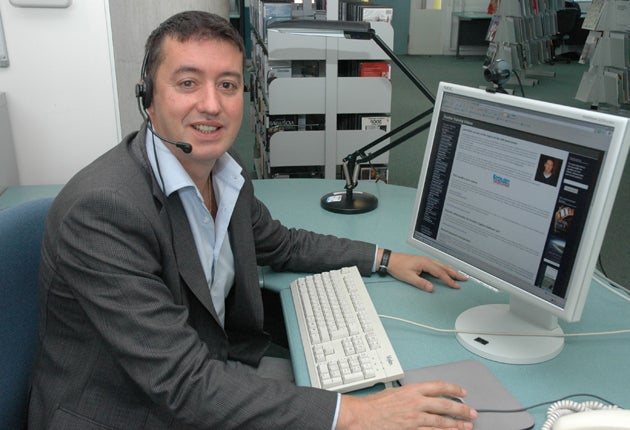Time to wave goodbye to old-fashioned lecture notes
When a lecturer made a video of himself marking essays, the world of academia realised he was on to something.

While marking a piece of written work by some Chinese students three years ago, their teacher Russell Stannard had a brainwave.
Instead of correcting their scripts in the traditional way, by making comments in the right hand margin and giving them a mark, he created a video of himself going through each one. This was a piece of cake for Stannard, who is principal lecturer in multimedia/ICT at the University of Westminster. "It allows you to record the screen of your computer as if you had a camera pointing at it," he explains. Each of the students, who were taking an English language course, had their lecturer's thought processes zapped over on a video, which they could open and listen to – as well as watch. It was as though they had received an individual tutorial from him.
Stannard worked through their sentences, explaining where a tense was wrong, or the grammar was incorrect, or the wrong word had been used, encouraging them to think about what the right usage would be. When they next met him, the students were ecstatic and gave him a round of applause.
The lecturer knew he was on to something. Since then Stannard's reputation has soared in the geeky world of educational technology. He won an award at his own university followed by a national prize at the Times Higher awards in 2008. This recognition led to funding from JISC, the body that inspires universities and colleges to make innovative use of digital technology, as well as grant money from the Higher Education Academy. Last month Stannard's work was cited by the National Student Forum in their report on ways that technology is being harnessed for teaching.
He has created two websites, one for teachers that shows them how to use programs such as Photoshop, Twitter or Wikimail, and the second for students.
This means that teachers and students who are interested in getting to grips with the range of new media on the internet can do so for free. They don't have to sign up for a course at Westminster University – though they would probably be well advised to do so, given Stannard's communication skills. "These websites are a way of promoting study at the university," he says. "We give people a lot of information, and hopefully they will choose to study here."
Two years ago there were 12 people on Stannard's multimedia Masters degree; now there are 19. One of the students who graduated last summer, Paul Trotter, 29, says that he chose the Westminster course because it looked so practical.
"There are many Masters degrees which are really open-ended and don't give you a lot of guidance," he says. "They just let you get on with it. But this course was about teaching the skills you need to know and that was important in making up my mind."
For Trotter, Stannard's feedback was particularly valuable. Academics' handwritten comments are often difficult to read and don't go into the kind of detail that you get in a Stannard video. "It's more on a par with having an interview with your teacher and discussing your work," he says. Plus, with a video, you can go over the material when and where you want to."
Stannard has made more general videos, giving students feedback that covers a whole class. This saves him time while helping students too. If students have been taking a class on presentations, say, he writes the key points on a screen – such as looking at their notes too much or not looking enough at the audience – and clicks the button. Everyone gets the video.
"It's useful because I don't have to go through that in the next lesson," he says. "I can provide it on the internet or on the virtual learning environment. Students say they love it and look at it when they need it. It saves me a lot of time. And I only have to make one."
Stannard has created another video to explain to students what he expects in their coursework. Again they can watch this on the day they plan to do their coursework as a refresher.
Is he worried this is too much spoon-feeding? Stannard plans to carry out research on this as part of his PhD but hopes he's not spoonfeeding.
Last year he conducted a small video experiment to test this, setting an essay on the use of interactive whiteboards for a class of English teachers. He marked each one in the traditional way, writing comments but withholding the marks and sent them videos containing the perfect answer.
The students were asked to figure out the mark they thought they deserved. The result was interesting. Not one student overpredicted his or her grade; and one got it right. This contrasted with Stannard's usual experience where students have an inflated idea of what they should get.
His websites are attracting attention: his receives 7,000 to 8,000 hits a month and is in great demand on the conference circuit. He has visited Spain, German, Italy, Japan and Malaysia to present his ideas and recently did a tour of Chinese cities. If you want to book him, get in quick.
Multimediatrainingvideos.com
Teachertrainingvideos.com
Join our commenting forum
Join thought-provoking conversations, follow other Independent readers and see their replies
0Comments